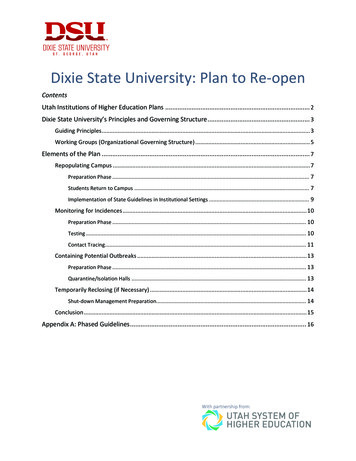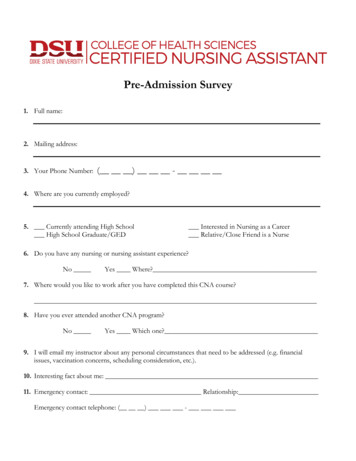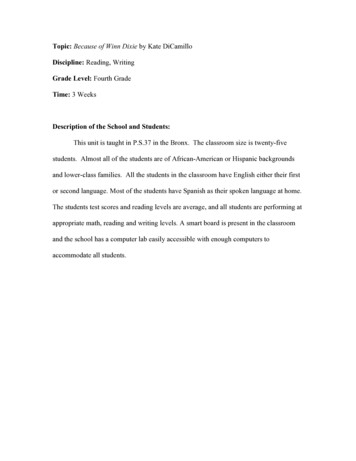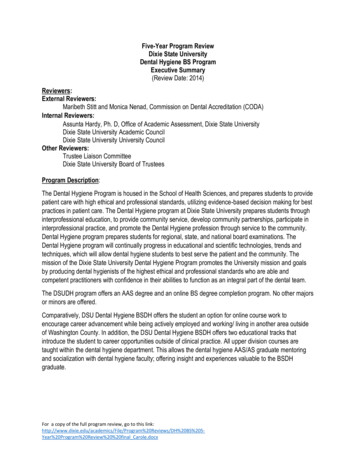
Transcription
Dixie State University: Plan to Re-openContentsUtah Institutions of Higher Education Plans . 2Dixie State University’s Principles and Governing Structure . 3Guiding Principles. 3Working Groups (Organizational Governing Structure) . 5Elements of the Plan . 7Repopulating Campus . 7Preparation Phase . 7Students Return to Campus . 7Implementation of State Guidelines in Institutional Settings . 9Monitoring for Incidences . 10Preparation Phase . 10Testing . 10Contact Tracing. 11Containing Potential Outbreaks . 13Preparation Phase . 13Quarantine/Isolation Halls . 13Temporarily Reclosing (if Necessary) . 14Shut-down Management Preparation. 14Conclusion . 15Appendix A: Phased Guidelines . 16With partnership from:
Utah Institutions of Higher Education PlansIn coordination with the Utah System of Higher Education (USHE), Utah institutions of higher education have beenasked by the Governor’s Office to develop individualized plans for re-opening campus to students. This documentis a template for each institution to use as they develop their individualized plans. The plan outlined in thetemplate will serve as a report to the Governor’s Office on their general approach, as well as a guide for studentsand their families to understanding each institution’s strategy for re-opening and welcoming students back tocampus. The plan is not an administrative playbook, but a guide for the general public to review and understand.The purpose of the template is to create alignment across the state of Utah for each institution of highereducation. Each institution will be enabled to incorporate their own ideas and unique circumstances andenvironments accordingly. The COVID-19 pandemic is a changing environment with new findings and research thatemerge on a daily basis. As such, these plans will be updated accordingly, but avoid granularity due to the evolvingenvironment.Dixie State University: Plan to Re-open2
Dixie State University’s Principles andGoverning Structure(This plan is a working document and will be updated regularly as new information and guidelines becomeavailable. To recommend updates, please fill out this form.)Guiding PrinciplesPurposeProtecting the safety of our students, faculty, staff, and guests is our top priority here at Dixie State University, andconsequently, we are committed to creating and following a plan to re-open that will establish a progressivepathway to keeping our campus community safe. As part of this effort, we will take extra precautions with themost vulnerable and high-risk populations while tracking health and economic indicators that will guide judgmentand decisions about reactivating campus life. This re-engagement plan is like a trail map, and like most trail maps,it will be updated as new findings and research become available. Adjustments will be made to the plan as neededto meet updated directives and guidelines.When the COVID-19 outbreak began to gain momentum, we tracked it early on. As it transitioned into a pandemic,we established our COVID-19 Task Force and subsequent sub-committees. We were prepared, having recentlyupdated our Emergency Operation Plan (EOP), accompanied procedures, and general pandemic plan, and quicklyturned these resources into a specific pandemic response plan for COVID-19. Moreover, we have followed allnational, state, and local guidelines and have consulted with safety, emergency, and public health care expertsregularly in our planning, mitigation, and response to the pandemic. Throughout the entire process, our toppriority has been keeping the best interest and safety of the campus community in mind. To this end, decisionshave been made responsibly, prudently, and with flexible resilience and balance. Science, verifiable data,applicable government guidelines, and advice from health care professionals will continue to guide our decisionsand response. Our official and continually updated response plan can be found at e Priorities The safety, health, and wellness of the campus community Incident stabilization and management Campus re-engagement and economic conservation Recovery and the continuation of University businessDixie State University: Plan to Re-open3
DSU’s Guiding Principles Reduce the likelihood of COVID-19 illness among students, faculty, staff, and guests of the University andreduce the impact of potential illness and exposure on campus by developing a mitigation and responseplan for the fall semester Establish a comprehensive testing and contact tracing protocol for the University in partnership withthird-party providers and the Southwest Utah Public Health Department (SWUPHD) Protect vulnerable and high-risk populations, following guidance from SWUPHD, USHE, Utah LeadsTogether, and the Centers for Disease Control Develop flexible and resilient strategies to minimize the disruption to our students, faculty, and staffthrough effective communication, resources, engagement, academic planning, and services Keep the campus community informed of new developments and actions the University is taking toprepare, respond, and maintain operationsDixie State University: Plan to Re-open4
Working Groups (Organizational Governing Structure)Policy Group: President’s Cabinet & USHE COVID-19 Task ForceIncident Command: Biff Williams, President, 435-652-7501Liaison Officer: Courtney White, Chief of Staff, 435-652-7534Communication Officers: Jordon Sharp, Vice President of Marketing & Communication, 435-652-7544Jyl Hall, Director of Public Relations, 435-652-7547Health & Safety Officer: Garyn Gulbranson, Director of Booth Wellness Center, 435-652-7755Risk Coordinator: Josh Thayn, Executive Director of Event Services & Risk Management, 435-652-7855Human Resources Officer: Travis Rosenberg, Executive Director of Human Resources, 435-652-7521Legal Officer: Becky Broadbent, General Counsel, 435-879-4242Planning Section Chief: Courtney White, Chief of Staff, 435-652-7534Campus Housing: Seth Gubler, Director of Housing, 435-652-7570Food/Dining: Katie Nye, Interim Director of Dining Services 435-652-7686Athletics: Jason Boothe, Executive Director of Athletics, 435-652-7526Behavior Modeling: Tasha Toy, Assistant Vice President of Campus Diversity/Chief Diversity Officer, 435-652-7735Events: Megan Church, Director of University Events & Promotions, 435-652-7907Finance Section Chief: Paul Morris, Vice President of Administrative Affairs, 435-652-7504Budget & Recovery Group: Bryant Flake, Executive Director of Planning & Budget, 435-879-4602IT Infrastructure: Gary Koeven, Chief Information Officer, 435-652-7770Logistics Section Chief: Scott Jensen, Executive Director of Business Services, 435-879-4603Procurement: Jackie Freeman, Director of Purchasing, 435-652-7612Payroll & Accounting: Kim Seaich, Director of Payroll, 435-652-7599Krystal Thompson, Director of Accounting, 435-652-7610Academic Operations Section Chief: Michael Lacourse, Provost, 435-652-7505Academic Instruction Resumption Branch: Bruce Harris, Associate Provost for Faculty Affairs, 435-879-4638Facilities Management, Building Operations & Custodial Services: Sherry Ruesch, Assistant Vice President ofFacilities Management, 435-652-7562Dixie State University: Plan to Re-open5
Student Affairs Section Chief: Peter Gitau, Vice President of Student Affairs, 435-879-4713Enrollment: Darlene Dilley, Assistant Vice President for Enrollment Management, 435-652-7704Sarah Vandermark, Associate Provost for Academic Success, 435-652-7510Engagement: Del Beatty, Assistant Vice President & Dean of Students, 435-652-7514Emergency Contacts: Emergency: 911 Public Safety Dispatch: 435-627-4300 Office of Risk Management and Safety: 435-879-4331 Booth Wellness Center: 435-652-7756 Facilities Management: 435-652-7550Dixie State University: Plan to Re-open6
Elements of the PlanRepopulating CampusPreparation PhaseTo ensure that Dixie State University is fully prepared to safely repopulate its campus, Dixie State Universityleadership will consult with state and local public health experts to confirm that it is safe to resume and continuecampus operations. The potential for a virus to spread by repopulating is not limited to the students themselves- itextends to faculty, staff, and the surrounding community. State and local health authorities will define andarticulate the metrics of prevalence to guide institutions in implementing needed mitigation.To fully prepare for students to safely return back to campus, Dixie State University will do the following.Students Return to CampusIn order to orient students and faculty to new on-campus safety protocols, Dixie State University will do thefollowing: Engage students, faculty, and staff in a positive welcome back campaign that shares the details of the reengagement plan as well as guidelines and restrictions they should follow when on campus Provide consistent, accurate, and timely follow-up messaging with state guidelines and local healthauthority recommendations Post campus signage in prominent locations to share guidelines and restrictions with the campuscommunity:oExterior of campus buildings: Large “welcome back” A-frames and signage that outlines the Stateof Utah’s guidelines for the color phase we are currently inoEntrances to campus buildings: Signage that encourages taking heightened hygiene measures,maintaining 6 feet of social distancing, and wearing face coveringsoFront desks of campus buildings: Signage that encourages monitoring of symptomsoThroughout buildings: Signage that is specific to each building and includes creative and wittymessaging that captivates students’ attention and motivates them to read all the signs theyencounteroCampus Dining facilities: Signage that outlines Southwest Utah Public Health Department’sguidelines for food handlingoAcademic building interiors: Signage that shares department-specific guidelines, as neededDixie State University: Plan to Re-open7
In order to manage the influx of students and faculty coming back to campus, Dixie State University will do thefollowing:Protective Measures Evaluate guidelines and gradually welcome employees back to campus using tiers; vulnerable populations’return will be delayed and/or they will be screened before returning Encourage taking heightened hygiene measures, maintaining 6 feet of social distancing, and wearing facecoverings Encourage individuals to stay home if they are symptomatic or sick Expect campus community members to self-monitor for symptoms, take their temperature daily, and fillout a health logoIndividuals’ temperatures should be under 100.4 Fahrenheit without the use of fever reducers tocome to campus Strongly encourage individuals to wear face coverings when they are not able to social distance Provide face coverings for those who need them oEmployees can secure face coverings from the HR officeoStudents can secure face coverings from the Dean of Students officeAdhere stickers to the ground 6 feet apart in areas where lines are formed to ensure social distance ismaintained Install plastic barriers at counters of high-traffic areas Use touchless systems for entry, payment, etc., when available; otherwise, provide disinfectant for wipingequipment after each transaction Have individuals wear gloves where appropriate, such as custodial and labsDisinfectant & Sanitation Deep clean campus with disinfectant, fogging, etc. prior to re-opening The custodial staff will aggressively clean facilities, paying special attention to heavily used and frequentlytouched areas Provide sanitation and disinfectant stations throughout buildings Encourage faculty and staff to frequently use disinfectant to spot clean their work spacesDixie State University: Plan to Re-open8
Encourage students and others on campus to disinfect areas they are touching by providing readilyavailable wipesClasses & Meetings Establish the occupancy of each classroom, lab, and meeting space based on safe distancingo Possibly allow for greater occupancy if all individuals wear face coveringsConsider face-to-face, high-flex, remote learning, and/or tiered instructionEvents Limit gatherings to 20 individuals when we are in the orange phase and 50 individuals when in the yellowphase Establish the occupancy of each event venue based on safe distancingoPossibly allow for greater occupancy if all individuals wear face coverings Situate tables 6 feet apart Follow the Higher Ed Event Task Force’s guidelinesBehavior Modeling & Training Require employees to complete the Return-to-Work document and NEOGOV training before returning tocampus Incorporate specific guidelines for individual departments, as needed Encourage employees to know and understand guidelines and restrictions and lead by example Prevent a culture of so shaming or policing based on adherence or lack of adherence to guidelinesOngoing Incident Monitoring & Assessment Monitor federal, state, and local guidelines and best practices Re-evaluate the re-opening plan and make adjustments as needed based on science, research, data, andtesting Commit to being flexible and resilientImplementation of State Guidelines in Institutional SettingsDixie State University will adopt the state of Utah’s public health guidelines, including wearing face coverings,physical distancing, and density restrictions for residence halls, dining facilities, and classrooms. Dixie StateUniversity will leverage the Utah Phased Health Guidelines to develop their own guidelines for relevantDixie State University: Plan to Re-open9
institutional functions that occur on campus. Dixie State University’s guidelines for varying institutional functionson campus can be found in Appendix A: Phased Guidelines.Monitoring for IncidencesPreparation PhaseTo ensure that Dixie State University is prepared to safely monitor for incidences on its campus, Dixie StateUniversity leadership will confirm that the state of Utah can prioritize necessary testing capacity to our campus.This includes testing capacity (with results) to test (or at a minimum, sample) incoming residential students, andadditional testing to monitor local outbreaks or other urgent circumstances. Such aggressive testing is critical tosuccessfully implement necessary quarantining, contact tracing, and other subsequent steps in mitigating anoutbreak.Dixie State University will also work with the state to ensure we have the adequate resources and capacity forcontact tracing.TestingTo fully prepare to monitor incidences on campus, Dixie State University will do the following for testing: To fully prepare to monitor incidents on campus, the University is looking into providing testing for faculty& staff through TestUtah. This testing benefit would be free to employees and would be used to establisha baseline for the higher-risk population of the university prior to students returning in the fall.oIf testing is offered and results are negative, employees will continue to comply with Universityguidelines of wearing face coverings while less than 6 feet apart from others (especially while inclose proximity for longer than 15 minutes), follow good sanitation practices, and daily selfmonitor for developing COVID-19 related symptoms§Employees who test negative for COVID-19 can continue to work on campus after theyhave gone 3 days without symptoms, submitted a copy of their negative test result tohr@dixie.edu, and completed the return-to-in-person form and associated trainingsoIf testing is offered and results are positive, employees will isolate at home and not return towork until they have gone three days without a fever (without using fever reducing medications),symptoms have improved, and it has been at least 10 days since symptoms first appeared; theemployee will then report to work and follow University social distancing and sanitationguidelinesDixie State University: Plan to Re-open10
§All employees will provide positive test results to the HR department, and will work withHR and their supervisor to explore possible plans for remote work and compensationduring isolation Employees and students receiving testing will be provided testing procedural instructions, along withinstructions to follow upon receiving negative or positive results If spread indicates clusters on campus, specific areas of infection will be selected for testing throughcommunity partners All employees and students presenting with at least one symptom will be referred to community partners(IHC and TestUtah) for diagnostic testingContact TracingTo fully prepare to monitor incidences on campus, Dixie State University will do the following for contact tracing: The University’s contact tracing for positive test cases and their firsthand contacts (those who havedirectly interacted with an individual with a conformed case of COVID-19) will be conducted by theSouthwest Utah Public Health Department with support from DSU nursing students, who will receiveclinical hours for performing community health services; nursing students will be trained by public healthepidemiologists Nursing students also will support the Booth Wellness Center staff on site in initial contact tracing effortsfor those exposed to positive test cases and suspected cases of COVID-19 (firsthand exposure to someonewho has COVID-19 related symptoms when no test results have been given) to mitigate risk of spread asquickly as possible on campus The University will encourage the campus community to use the Healthy Together app to assist in contacttracing as well as assessing symptoms and learning what to do if they test positive for COVID-19. Within 48 hours of the onset of symptoms, the measuring stick to assess for risk of exposure is a firsthandcontact with less than 6 feet distance for longer than 15 minutes without wearing face coverings Employees and students determined to be at high risk for exposure will be sent home for quarantine andinstructed to monitor for developing symptomsoEmployees will be instructed to contact their supervisor, inform them of their quarantine status,and work with HR and their supervisor to create a plan for remote work and compensationduring quarantineoStudents will be instructed to contact their professors/instructors and inform them of theirquarantine status and ensure remote delivery of coursesDixie State University: Plan to Re-open11
Those who come into contact with a positive COVID-19 case and are symptomatic, will immediately bereferred to a community partner for testingoIf results are negative, they may return to work or school after 3 days have passed withoutsymptoms (without utilizing fever-reducing medications) Employees who have had secondhand contact (not coming into contact with a positive COVID-19 casedirectly, but coming into contact with someone who has been in direct contact with a positive COVID-19case) are not required to work from home or quarantineoIndividuals should monitor their health for COVID-19 related symptoms for 7 days from the dateof possible exposure and if symptoms present, employees should notify their supervisors, stopworking, get tested, then proceed based on their test resultsoOne’s exposure to COVID-19 is diminished, in either a firsthand or secondhand contact situationif the employee was wearing a face covering while less than 6 feet apart from others (especiallywhile in close proximity for longer than 15 minutes), and if they followed good sanitationpractices of frequent handwashing or using hand sanitizer Those who come into contact with a positive COVID-19 case and are asymptomatic will be sent home tomonitor for developing symptoms for 7 days; if they do not develop symptoms within that timeframe,they may be tested and provide a negative test result to return to work or school 10 days after theyreceived their test or they may complete the 14-day quarantine and return to work or school Those who come into contact with a suspected COVID-19 case and are asymptomatic will be instructed tostay home and monitor for the development of symptoms for 3 days, or until the suspected case hasreceived a negative test result, at which point they may return to work or school If individuals develop symptoms while in quarantine, they will inform the Booth Wellness Center of theirstatus, be referred to a community partner for testing, and provide test result to the Booth WellnessCenteroIf the results are negative, the employee or student will return to work or school after 3 dayshave passed without symptoms (without utilizing fever reducing medications) and will complywith University guidelines by wearing face coverings while less than 6 feet apart from others(especially while in close proximity for longer than 15 minutes), follow good sanitation practices,and daily self-monitor for developing COVID-19 related symptoms If employees or students live with someone who is COVID-19 positive and they do not quarantineseparately from them in their house, they must go through the 10-day quarantine period with the positivecase and then begin their own 14-day quarantineDixie State University: Plan to Re-open12
oIf the employee or student remains asymptomatic, on day 7 of their quarantine, they may betested and with negative results, return to work or schooloIf they choose to quarantine separately, they may conclude their quarantine with the positivetest case on day 10 as long as they have not developed symptomsoIf they develop symptoms at any time during quarantine, they should be tested immediately andfollow protocols based on negative or positive test resultsContaining Potential OutbreaksPreparation PhaseTo ensure that Dixie State University is prepared to contain a potential outbreak on its campus, Dixie StateUniversity leadership will confirm that the State will ensure that adequate supplies of personal protectiveequipment (PPE), face coverings, and other supplies will be available for use. Dixie State University will also ensurethat adequate surge capacity is available in nearby health care facilities and hospitals to handle a potential campusoutbreak.Quarantine/Isolation HallsTo fully prepare to contain potential outbreaks on campus, Dixie State University will implement the followingprotocols for quarantine/isolation halls: Students in quarantine/isolation will be given a thermometer (if needed/available) for self-monitoring Meal delivery service for students in quarantine/isolation will be coordinated with Dining Services Mini-refrigerators and microwaves will be available in quarantine/isolation rooms The Housing Office will coordinate food delivery from the Food Pantry with the Dean of Students Officefor students in quarantine/isolation The Housing Office will coordinate remote education needs with Academic Affairs through the Dean ofStudents Office for students in quarantine/isolation Resident managers and resident assistants will maintain regular contact with students inquarantine/isolation through technological means to assess needs and provide support The COVID-19 coordinator will be made aware of students in quarantine/isolation for contract tracingpurposesDixie State University: Plan to Re-open13
Temporarily Reclosing (if Necessary)Shut-down Management PreparationDixie State University will be flexible and plan for contingencies where teaching and learning continue to take placevia remote or hybrid delivery of instruction and include scenarios for full or partial physical reopening.To fully prepare to manage a temporary reclosure of campus, Dixie State University will do the following:Temporary Closing/Reclosing of Campus The University president (or a designee or the next available individual in the chain of command, if thepresident is unavailable) will work closely with public safety, public health, and emergency officials todetermine if the University needs to reclose The University will rely on its response levels to guide administration in making decisions abouttemporarily reclosing campusoLevel 1 (Confirmed cases exist of human-to-human transmission of a potential pandemic illnesswith a probability of reaching the U.S.): Campus is open and the University functions as usualoLevel 2 (Confirmed cases have reached the U.S.): Campus is open, and the University beginspreparations for Level 3 and notifies SWUPHDoLevel 3 (Cases are suspected on campus or confirmed in the state of Utah): Campus is open, andthe University implements social distancing, prepares to cancel classes and/or scheduledactivities, prepares for probable campus closure, and notifies SWUPHDoLevel 4 (Confirmed cases are on campus): The University considers closing, declares the situationto be an emergency condition, considers closing facilities except for skeletal services, establishestemporary housing if needed, secures access to campus and notifies SWUPHDoLevel 5: (Recovery Operations): The University prepares to re-open campus and facilities,resumes classes and/or scheduled activities, continues to encourage social distancing, andnotifies SWUPHD The Coronavirus Task Force will implement our campus closure planoThe task force will review our campus closure plan from the Spring 2020 semester, analyze whatwent well and what went wrong, and make and implement any necessary changes Faculty will develop remote learning options for their classesDixie State University: Plan to Re-open14
An announcement will be sent through the Dixie Alert System via texts, emails, phone calls, and computeralerts as well as posted on the DSU website, University’s official social media pages, and TV screenslocated throughout campus The Coronavirus Task Force and University Marketing & Communication will update our COVID-19Emergency Response Plan, which we will continue to follow and use to inform the campus community ontopics such as: oCampus OperationsoClasses, Coursework, and Community EducationoStudent ResourcesoEmployee InformationoTesting & Self-IsolationoEvents, Commencement, Meetings, and Athletic GamesoStudent, Faculty, and Staff TraveloThe Spread of Symptoms of Covid-19The University will follow federal, state, and local regulationsConclusionIn line with our commitment to protecting the safety of our students, faculty, staff, and guests, this plan preparesDSU for a successful re-opening and economic and institutional recovery. We are excited to safely re-populate andre-engage with our campus community, which we will accomplish by educating those on campus, adhering toguidelines, protecting vulnerable populations, continuously monitoring for COVID-19 incidences, and conductingdiagnostic tests as necessary. We will continue to assess the ever-changing landscape using proven science,verifiable data, best practices and public health expert consultation. DSU will implement updated procedures ifnew information on the virus becomes available. DSU has successfully operated in the red, orange, and yellowphases and is equipped to move to green or back and forth through phases. By being flexible, communicative, andresilient, we will continue to offer our students a high-quality education and our unique “active learning. activelife.” experience throughout this pandemic and beyond.Dixie State University: Plan to Re-open15
Appendix A: Phased GuidelinesHigh RiskIntensity of DisruptionGeneral Guidelinesfor All Areas1234567Moderate Risk89101234567Low Risk89101234567New Normal Risk891012345678910Only mandatory employees and functions are allowed oncampus.Employers exercise extreme caution, make every possibleeffort to enable working remotely, evaluate workforceconcerns, and enact strategies to minimize economicimpact. Departments that necessitate on-site work shouldmonitor workforce for symptoms and well-being andprovide accommodations to high-risk employees.Employees should comply with di
Dixie State University: Plan to Re-open 6 Student Affairs Section Chief: Peter Gitau, Vice President of Student Affairs, 435-879-4713 Enrollment: Darlene Dilley, Assistant Vice President for Enrollment Management, 435-652-7704 Sarah Vandermark, Associate Provost for Academic Success, 435-652-7510 Engagement: Del Beatty, Assistant Vice President & Dean of Students, 435-652-7514










